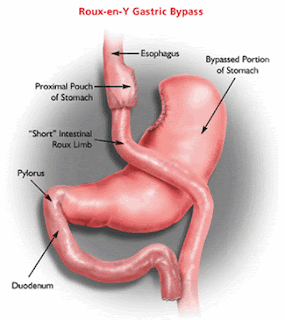Saturday, July 26, 2008
Technological Fixes
1. Creation of a small stomach pouch
During this part of the surgery, the stomach is divided into a large portion, and a much smaller portion. The small partof the stomach is then sewn or stapled together to make asmall pouch (this part is sometimes called "stomachstapling"). The small stomach pouch can only hold a cup orso of food.With such a small stomach, people feel full quickly and eatless. This strategy is also called "restrictive," since the new stomach size restricts food intake.
2. "Roux-en-Y" creation (bypass)
In this part of the surgery, the new, small stomach pouch isdisconnected from the first part of the small intestine (theduodenum). The surgeon then reconnects the stomach to aportion of intestine slightly further down (the jejunum). This surgical technique is called a "roux-en-Y." After a roux-en-Y, food passes directly from the stomach into the jejunum, bypassing the duodenum. This leads to reduced absorption of calories and nutrients. This weightloss method is called "malabsorptive." Stomach stapling and gastric bypass are typically performed during the same surgery. Together, this surgery is called a"roux-en-Y gastric bypass." The roux-en-Y procedure accountsfor about 80% of all U.S. weight loss surgery procedures.Usually, gastric bypass is performed laparoscopically (usingtools inserted through small incisions in the belly). When laparoscopy is not possible, gastric bypass can be open(laparotomy). This involves a large incision in the middleof the belly.
What to Expect After Gastric Bypass Surgery
Complications
Nearly 10% of people have complications after gastric bypasssurgery. These are usually minor:
Wound infections
Digestive problems
Ulcers Bleeding
Nearly 1% to 5% of people have serious or life-threatening complications:
Blood clot (pulmonary embolism)
Heart attack
Leak in the surgical connections with the intestines
Serious infection or bleeding
The risk of complications is lower at centers that perform more than 100 weight loss surgeries per year. And, when performed by a highly experienced surgeon, deaths in the month following gastric bypass surgery are rare: about 0.2%to 0.5% (less than 1 in 200 people).
Recovery
After gastric bypass surgery, people typically stay in the hospital for two to three days and return to normal activitywithin two to three weeks.
Weight Loss
Weight loss after gastric bypass surgery is often dramatic. On average, patients lose 60% of their extra weight. For example, a 350-pound person who is 200 pounds overweightwould lose about 120 pounds.
Taken from webmd.com(http://www.webmd.com/diet/weight-loss-surgery/what-is-gastric-bypass-surgery)
by,
rob
Friday, July 25, 2008
Global Strategy on Diet, Physical Activity and Health
1. Reduce risk factors for chronic diseases that stem from unhealthy diets and physical inactivity through public health actions.
2. Increase awareness and understanding of the influences of diet and physical activity on health an the positive impact of preventive interventions.
3. Develop, strengthen and implement global, regional, national policies and action plans to improve diets and increase physical activity that are sustainable, comprehensive and actively engage all sectors.
4. Monitor science and promote research on diet and physical activity.
Reducing Obesity
Just recently on July 24, an article in Medpage today, a medical magazine, published an article titled "Congress Urged to Act to Help Childhood Obesity Rates." This article urges congress to take a more forceful action in the increasing obesity rates among children. Dr. Thompson, Arkansas surgeon general, and colleagues have passed along some suggestions to help stop child obesity. Dr. Thompson stated that Arkansas used school based programs to lessen childhood obesity in the state of Arkansas, which is often ranked at the bottom of the least healthy states in the United States. In 2003, state legislation created a childhood obesity prevention program that established physical activity requirements, increased access to healthy foods in schools and mandated issuing confidential body mass index report cards for all public school children. Dr. Thompson states "we've done everything we can think of at the state level; we need the help of Congress and local governments to do more."
Among other suggestions:
1. Give the U.S. Department of Agriculture broader authority to regulate foods sold in vending machines and schools.
2. Increase federal reimbursement rates for school meals to offset the pricier cost of foods.
3. Reauthorize No Child Left Behind to require schools to report a "physical education quality score," in addition to academic scores.
4. Boost funding in the federal surface transportation bill for the "Safe Routes to School" program so children can safely walk or bike to school.
5. Create incentives to spur responsible land use decisions that encourage walking and biking in more communities.
6. Include obesity as a treatable condition in the State Children's Health Insurance Program and Medicare plans.
Technology and Obesity
Fast food restaurants have become mainstream in the past 30 years and most of America takes advantage of the cheap prices and quick service. However, these meals contain practically no nutrients. They are comprised mostly of saturated fats and highly refined carbohydrates and are loaded with sodium and sugar. The average adult should not have more than 65 grams of fat or 2000 calories a day. One meal from Burger King, a hamburger and french fries, has 50 grams of fat and 2000 calories, which is enough to fill someones fat and calorie intake for the day!
Advertising also plays a big role in nutrition. The average child sees more than 10000 food ads on TV each year, most high calorie, high fat and high sugar meals. The fast food industry spends billions each year on marketing not only on TV but in schools systems as well. Our children are bombarded from every way possible with low nutritious food that it makes it impossible to want to eat anything else. It comes to no surprise that we have an increasingly obese population of children which than leads to obese adults.
History
below is a website that shows a timeline of obesity from 1908 to 1996
http://www.naafa.org/press_room/history_obesity.html




